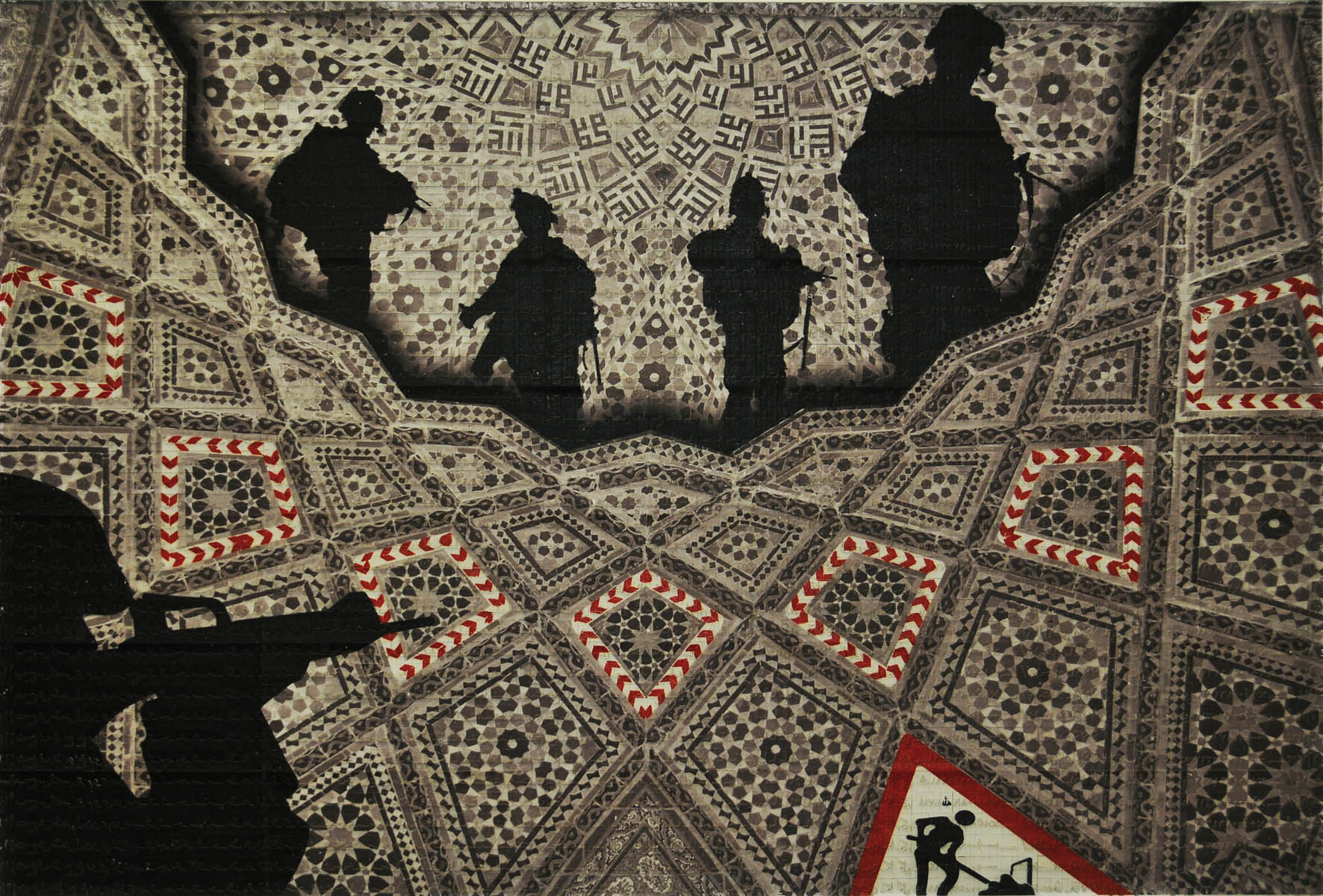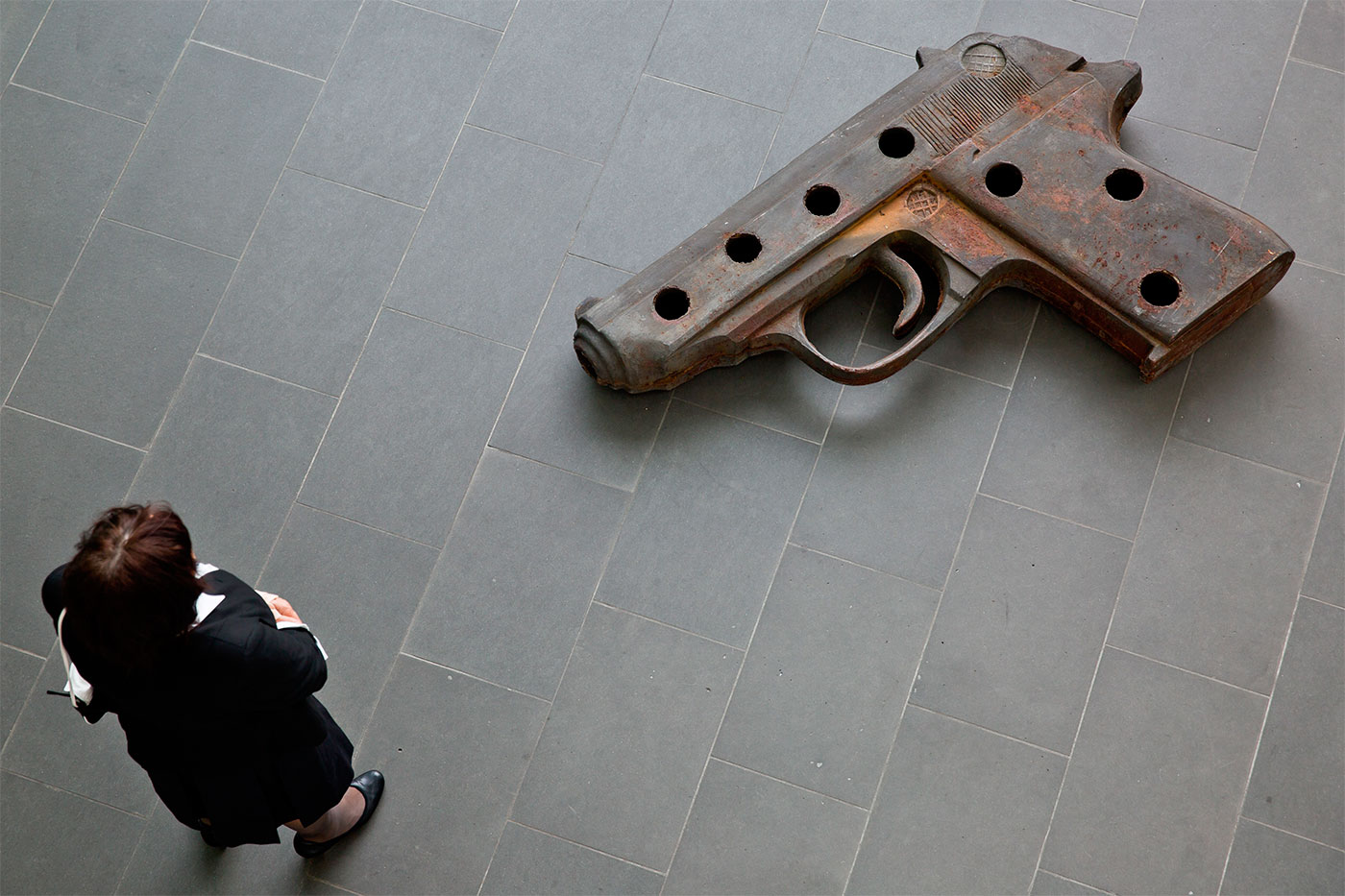From Post-Modernism to Neo-Modernism
Teun Hocks, Untitled, 2000
(no votes) |
(0 votes) |
Ph.D. in History, Academic Director of the Russian International Affairs Council, RIAC Member
The need to admit the fact that the agenda of post-modernism is considered exhausted not only by the fringes of society but also by the middle class and even a large part of the global intellectual elite. Foreign-policy post-modernism has degenerated into a trivial desire to keep the status quo, and this alone made it doomed. Even if the supporters of the European Union had won in the UK referendum and Donald Trump had been defeated by Hillary Clinton, these circumstances could only have delayed, but not prevented, the end of the era of post-modernism. Even if the advance of neo-modernism is stanched on one front, and if the post-modernist underground partly succeeds in undermining it from inside, the world will never go back to the golden age of post-modernism.
It is common knowledge that the concept of post-modernism came into international relations lexicon from the French philosophy of the 1970s-1980s. Shortly before the end of the last great rise of French intellectual universalism, Jacques Derrida, Michel Foucault, Louis Althusser, Jacques Lacan and other founders and opponents of post-structuralism formulated the basic characteristics of post-modernism as an integral sociological and historical interpretation of the modern world.
Most often cited are four of them. The first one is agnosticism that claims that truth is relative and is no more than a generally accepted view rather than a reflection of objective reality. The second one is pragmatism, which holds that the only unquestionable value is success, and success is measured solely by material achievements of individuals or their groups. The third one is eclecticism that maintains that in order to succeed an individual and society randomly blend conflicting principles, strategies and behavioral models. The fourth one is anarcho-democracy, which states that the combined effect of agnosticism, pragmatism and eclecticism consistently destroys the legitimacy of any social and political hierarchy by opposing it with a completely free “atomized” personality.
Many may find these characteristics bleak and undoubtedly inferior to the consistent and clear rationalism of classical modernism. In fact, many founders of post-modernism regarded it as a philosophy reflecting the crisis of Western conscience. Nevertheless, one should not overlook the strong sides of post-modernism, primarily its inclusive nature and ability to offer a “common denominator” to the very complex, heterogeneous, divided, and contradictory Western society of the late 20th and early 21st centuries. It is not surprising, therefore, that this concept made its way into international relations to be applied not just to Western society, but also to the extremely complex, heterogeneous, divided, and contradictory world at large.
The Short Age of Post-Modernism
Having migrated from philosophy and sociological theory into real international relations, the four characteristics of post-modernism could not but be modified. However, in a modified form, for almost three post-Cold War decades they not only reflected the global political establishment’ views on the world but also reflected on concrete foreign-policy priorities and activities of great powers, international organizations and other global players in the West and, to a considerable degree, in the rest of the world as well. Although Bill Clinton, Tony Blair, Nicolas Sarkozy or Jose Manuel Barroso never positioned themselves as “post-modernists,” the paradigm of post-modernism can easily be seen in their international activities.
As far as international relations are concerned, postmodern agnosticism has acquired the form of legal relativism whereby basic norms of international law (sovereignty, non-interference in the internal affairs of other states, rejection of military force, etc.) are applied selectively depending on the current political situation and needs of main players. There emerged a gap between the “legality” and “legitimacy” of foreign-policy activities and this gap kept growing. Unlawful “legitimacy” (based on a “generally accepted view” held by the extremely amorphous “world public opinion”) was more and more often preferred to formal juridical “legality.” Legal relativism was closely followed by moral relativism (for example, in dividing terrorists into good and bad guys depending on situational political needs).
Pragmatism transformed into economic determinism when foreign policy began to be viewed as a purely technical mechanism for servicing immediate economic interests of national and transnational business elites. All other interests–from preserving national culture to protecting national security–were declared annoying, albeit unavoidable, rudiments of the bygone era of modernism or even earlier epochs. Pragmatism also resulted in the worldwide rejection of major long-term political projects such as UN reform or transformation of NATO into a universal Euro-Atlantic security organization. Such projects required significant political investments, had long recoupment periods and from the point of view of plain pragmatism were irrational, impractical, and irrelevant. It was much more logical to expand existing institutions at minimum cost and political risk.
Eclecticism can be detected in numerous instances of double standards, controversial and inconsistent foreign-policy narratives, widespread hypocrisy, preterition, and “political correctness.” Tactics increasingly prevailed over strategy, and political rhetoric was drifting father and farther away from political practice. The desire to satisfy numerous group interests, keep fragile consensus on key international issues, and minimize political risks and potential costs made major political breakthroughs practically impossible. Eclecticism also steadily ruined what little was left of national ideologies (“big narratives”) after the global triumph of liberalism at the end of the 1980s and the beginning of the 1990s.
Finally, anarcho-democracy manifested itself at least on two levels. Inside countries, the dominant role of the state in determining and carrying out foreign policy came under fierce attacks from numerous non-state actors such as large corporations, public organizations, regional authorities and municipalities, political parties, and religious movements. At the interstate level, international organizations, both regional and global, faced a serious challenge worldwide. It was a sort of “geopolitical deconstruction” replacing rigid structures wherever possible with flexible tactical alliances (“coalitions of the willing”) where every member could determine the format and degree of its involvement without making any firm or long-term commitments.
As a philosophical and sociological construct, post-modernism reflected Western society’s fatigue from mobilization discipline and hard rationalism in the era of modernism. As a global political phenomenon, it reflected the international community’s fatigue from strict hierarchy and Manichean dualism of the Cold War era. Both softened their requirements on the subjects of social activity: the “atomized” individual in the former case, and the nation state in the latter case.

Imperatives of Neomodernism for the Middle
East
This softening exposed both the obvious attractiveness of postmodern approaches and their historical narrowness, which was equally obvious. So far no one has been able to replace action with its imitation, policy with rhetoric, strategy with tactics, principles with opportunism, and sober analysis with “political correctness” for an indefinitely long period of time. Postmodern politicians were not an exception. The inevitable decline of post-modernism in world affairs was accelerated by the sad fact that, unlike postmodern philosophers, postmodern politicians appeared to be disinclined for reflection, doubt or critical evaluation of their own experience, thus proving unable to make prompt corrections and introduce new ideas to the political practice and missing the “point of no return” in the development of the international system.
The era of the unchallenged reign of post-modernism in international relations, at least in the form it had assumed by the end of the last century, was very short by historical standards. When exactly its decline began is an arguable point. Looking back on past events, some analysts say that 2016 was a watershed year and insist that Brexit and Donald Trump’s victory in the U.S. elections were the “points of no return.” Others believe that the era of post-modernism ended two or three years earlier when the Ukraine crisis broke out and the “Greater Europe” project failed. Still others go even further back in time, recalling the “Arab awakening” in 2011 as an event that had not only a regional, but also a truly global impact. And some cite the 2008-2009 financial and economic crisis or rather the inability and unwillingness of the postmodern world elite to come up with any adequate response, make necessary sacrifices for the sake of common interests and take the international currency and financial system to a new level of governance.
Let us leave the dating alone and simply state the obvious: in the second decade of the 21st century we can see the reemergence of some key parameters from the era that proceeded post-modernism. Since no restoration presupposes exact reestablishment of the ancien régime, we should be talking about a new stage in the development of the international system. Borrowing the term used by Russian researcher Vassily Kuznetsov in his analysis of the contemporary sociopolitical dynamics in the Middle East, we can say that international relations today are entering a neo-modern period.
In present-day architecture, neo-modernism rejects the excessive elaborateness and complexity of post-modernism for the sake of a simpler and clearer style. Neo-modern architects prefer a brutal and minimalist manner, avoiding lavishly decorated facades and choosing straight lines and right angles instead of numerous curves and rounded corners. They use a lot of metal and composite materials that render the impression of emotional restraint and inner strain. One can clearly see some parallels with international constructs being built by contemporary neo-modern politicians.
Neo-Modernism as a Negation of Post-Modernism
A countless number of articles, reports, essays, and books have been written, conferences, symposiums and other collective events held to explain unexpected and almost incredible victories recently won by neo-modernists. Sometimes their successes are attributed to certain situational factors such as a concourse of political circumstances, the charisma of neo-modern leaders, or tactical blunders of their opponents, etc. Neo-modernists’ successes are often explained by their ability to mobilize marginalized sections of the population, hypnotize masses and stir up dark depths of public subliminal consciousness where “normal” post-modern politicians would never dare pry (to quote J.R.R. Tolkien, “…evil was stirred up in Moria again…”). Conspiracies are also part of this ploy, with Vladimir Putin pulling the strings in a neo-modern plot as a global mastermind and the boss of all neo-modernists.
Intentionally or not but such explanations distract attention from the main issue, that is, the need to admit the fact that the agenda of post-modernism is considered exhausted not only by the fringes of society but also by the middle class and even a large part of the global intellectual elite. Foreign-policy post-modernism has degenerated into a trivial desire to keep the status quo, and this alone made it doomed.
Even if the supporters of the European Union had won in the UK referendum and Donald Trump had been defeated by Hillary Clinton, these circumstances could only have delayed, but not prevented, the end of the era of post-modernism. In fact, neither David Cameron nor Hillary Clinton had even tried to offer a new and attractive perspective to their potential supporters but only scared them with catastrophic consequences if the vote went the “wrong” way. As one of the characters in O. Henry’s story said, sand is a not a palatable substitute for oats, but post-modernists failed to offer anything more substantive.

The Middle East: Postmodernism Is Over
Equally erroneous, in my opinion, is the view that there is some united global front of neo-modernists who are advancing on post-modernism like hoplites in a Macedonian phalanx. Russian President Vladimir Putin is not marching along with Polish leader Jaroslaw Kaczynski, and Chinese President Xi Jinping is not very close with Japanese Prime Minister Shinzo Abe. If Francois Fillon becomes the next French president, he is unlikely to be a comfortable partner for his American vis-à-vis Donald Trump. Nor France’s National Front leader Marine Le Pen has much chance to become British Prime Minister Theresa May’s best friend.
We are not talking about some international political alliance like the Holy Alliance in Europe after the Napoleonic Wars or the Communist International. What we see is a number of identical, converging or close views on world affairs, on their laws and driving forces, on negotiation strategies and tactics, on foreign-policy success criteria and indicators, and on the future of the world political and economic order. These unorthodox views that seemed to be outdated, antiquated and marginal are now characteristic of the new cohort of national leaders and the political forces behind them.
Each of them challenges the post-modern paradigm one way or another, distances himself/herself from its basic characteristics and offers his/her own version of the neo-modern agenda for a country, a region or the international community as a whole. The decrepit citadel of post-modernism is being stormed from different sides, with the storming forces having no single plan and yet having much in common. Accepting inevitable accusations of schematism and unlawful generalizations, I will nevertheless take the liberty of naming four basic characteristics of neo-modernism that stand in opposition to the four post-modern tenets, which until recently were considered generally accepted.
Firstly, it is nationalism. All heralds of the new era invariably emphasize specific national interests of their countries as opposed to post-modernists’ global universalism. It is quite noteworthy that during his election campaign Donald Trump spoke not about “American leadership” but about “America’s greatness.” Nationalism, like nothing else, unites Western and non-Western neo-modern leaders. While post-modernists diligently tore down walls along the “friend or foe” line, neo-modernists are rebuilding those walls just as diligently (even literally like Hungarian Prime Minister Viktor Orban or his Israeli colleague Benjamin Netanyahu). Nationalism is closely associated with the strong belief in the central role of the state in world politics. Post-modern attempts to challenge the hierarchy of legitimacy and present the state as just one of the global political players are resolutely brushed away as irresponsible and untenable.
Secondly, it is transactionalism. The transactional approach in foreign policy likens joint work with partners and opponents on the international stage to business relations where each negotiating party bargains for the best possible terms. Abstract notions like ‘common values,’ ‘interests of humanity’ or ‘world public opinion’ may be mentioned but generally are not frequently used and certainly do not reflect key priorities. Demonstrative transnationalism can be considered a legitimate reaction to the numerous ambiguities, double-speak, hypocrisy, and “political correctness” in the post-modern era. Transactional rhetoric, which sometimes borders on cynicism, wins much more trust and support among people than high-flown declarations made in the retro post-modern style.
Thirdly, it is holism. The commitment to holism, or, paraphrasing Jan Smuts, “foreign policy of the wholes,” exposed the fallaciousness of economic determinism advocated in the era of post-modernism. The last several years have clearly shown that foreign policy can instantly turn from a slavish servant of the economy into its capricious mistress. Interestingly, the political triumph of Eurosceptic Jaroslaw Kaczynski coincided in time with Poland’s unprecedented economic successes achieved due to its active role in European integration. The principle of holism, a thing Jaroslaw Kaczynski and Vladimir Putin paradoxically have in common, deprives the economy of its central place in foreign policy priorities by paying just as much attention to national security, ethnocultural identity or state sovereignty.
Fourthly, it is historicism. While post-modern leaders drew inspiration from fantasies about the global future of mankind, neo-modernists who are taking their place are much more willing to look for political beacons in their national past. This revives seemingly forgotten “big narratives,” especially noticeable in France and Japan (clearly, they never ceased to exist in Russian, China, and India even in the best post-modern times); this provokes a resolute rejection of post-modern universalism, warrants increased attention to national myths, and generates explicit or disguised claims of exclusiveness. While for post-modernists the term ‘normal country’ had a clear positive meaning, it is completely void of any meaning for neo-modernists. Although in terms of political tactics most neo-modernists position themselves as pragmatic transactionalists, they clearly gravitate towards historical romanticism in terms of worldview, evoking memories of timeless novels written by Victor Hugo or Walter Scott.
There is yet another, less obvious, distinction between neo-modernists and post-modernists. It the era of post-modernism, the main divide in world politics was the watershed between democracy and authoritarianism. The advance of democracy and the ousting of authoritarianism to the sidelines of the emerging global civilization were viewed as the main purpose of global development. For the majority of neo-modernists the question of democracy and authoritarianism is drifting into the background, giving way to an issue they consider much more important, namely the border between order and chaos in international relations. In the second decade of the 21st century the world has entered a period of chronic instability, regional and global turmoil, and a dramatic decline in the governability of the international system, and keeping the emphasis on the advance of democracy would be an unaffordable luxury—at stake is not development but survival, not prosperity but security.
Negation of the Negation?
It would be at least premature to declare the full and final victory of neo-modernism over post-modernism. The latter continues its desperate resistance to the new paradigm, fighting it fiercely on several fronts at the same time. The main pocket of resistance in Europe is Germany, which under Angela Merkel has been holding the post-modern bridgehead in the center of the continent, every year losing more allies and companions. In the United States, numerous groups from the liberal establishment, entrenched in leading newspapers, Washington-based analytical centers and Congress, are conducting guerrilla warfare. The majority of small countries are opposing neo-modernism across the world, because “the new reality” they have been offered generally reduces their freedom of maneuver and denies them political and economic bonuses by way of “positive discrimination.” Naturally, resistance fighters should also include a large number of big business leaders, bureaucrats in international organizations, and transnational civil society activists who are not willing to put up with the new hierarchy and new ideology in world politics.
Even if the advance of neo-modernism is stanched on one front, and if the post-modernist underground partly succeeds in undermining it from inside, the world will never go back to the golden age of post-modernism. Elvish ships are quietly departing from the Grey Havens, the last Elven princess, who never became lawful queen, is casting a sad glance at the receding shores of Lindon she is leaving forever, while a new dawn is already lighting up the sky above Middle-Earth.

Discipline and Punish Again?
How long will this new era last? Several years or several decades? And what will come next? Answers to these questions depend in the first place on whether neo-modernism proves able to develop, evolve and correct mistakes, diligently although not always passionately, which post-modernists never bothered to do. One cannot but notice that the four basic symbols of neo-modern faith are as unreliable, internally contradictory and exposed to opponents’ criticism as the four tenets of post-modernism were unreliable, relative, controversial, and vulnerable.
To what extent can nationalism act as a mechanism for long-term sociopolitical mobilization in the 21st century? Globalization processes are still in progress and, therefore, individual and group identities are multiplying, transboundary migration is growing and cultural and anthropological unity, which is so vital for nationalism, is eroding. Would it be realistic today to present the national idea as a “big narrative” making up for the shortage of religious conscience the way it was done in Europe a hundred or two hundred years ago?
And what about transactionalism? Doesn’t it bear the birthmarks of post-modernism when it places “concrete” momentary achievements above “abstract” future interests? Doesn’t it sacrifice strategy to tactics and the general to the particular the same way post-modernism once did? And what about the urgent need for long-term and politically costly projects to restore the governability of the political system? One can hardly expect this enormous challenge to be solved by a simple sum-total of numerous individual transactions between different international political players.
There are also many questions to foreign-policy holism, because holism is not only about looking for a balance between the economy and politics, between integration and sovereignty. Holism is based on the conviction that every country has its own unique destiny and its foreign policy should perform a special international mission. This is why a national leader should not seek to balance out different group interests but listen to the rumble of the “drums of destiny,” articulate a national mission and consolidate society around it. This epic task can be effectively handled by the leaders of authoritarian regimes where the foreign-policy decision-making process is overly centralized. But how can this be done in democratic societies with their “checks and balances,” where lobbyists and the media play a significant role and any major political decision is adopted one way or another through compromises and mutual concessions?
Historicism also contains numerous dangers and traps. Paraphrasing Herzen’s remarks about Westernizers and Slavophiles, it would be appropriate to say that post-modernists take the world as a prophecy, while neo-modernists view it as a reminiscence. The prophecy turned out to be cooked up by self-obsessed dilettantes, crude and short-lived, and the reminiscence may actually be daydreaming leading one away from the real world. Moreover, a clash of mismatching “big narratives” can cause acute political conflicts as vividly proved by the Chinese and Japanese versions of the history of World War II in Asia. Besides, how long can one walk forward while looking backward all the time?
It should be noted that just like in architecture, neo-modernism in international relations allows for simplification, wholeness, minimalism, and to some extent even demonstrative anti-intellectualism, while modern society keeps accumulating elements of complexity, nonlinearity, ambivalence, and fragmentation. Sociocultural processes recorded by French post-structuralism some forty years ago are still underway and have actually acquired new dimensions and new dynamics. This makes an escalation of tension between the social base and the political superstructure almost unavoidable.
Will we see a convincing revenge by post-modernism? Will such terms as ‘neo-postmodernism’ or ‘post-neomodernism’ make their way into our vocabulary? Hardly anyone can give a conclusive answer to these questions today. The world political and academic communities will most likely miss the decline of neo-modernism just as they missed its rise. But one thing is clear—in the future political game those will have the best chances to win who are prepared to follow Socrates’ advice, relevant up to date: The secret of change is to focus all of your energy not on fighting the old, but on building the new.
First published in Russia in Global Affairs.
(no votes) |
(0 votes) |






